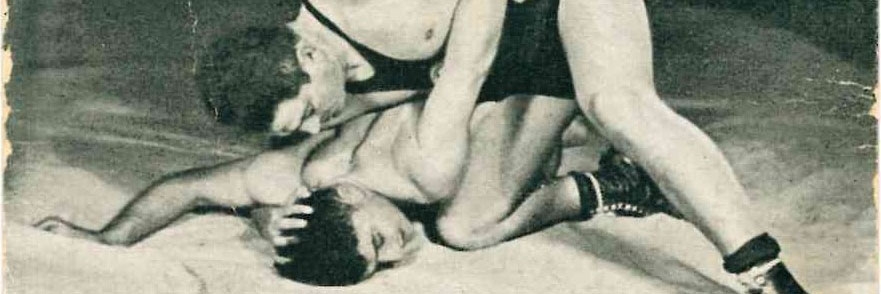
Neue Archivsammlungen
The Leo Baeck Institute is continually collecting new archival materials related to the history of German-speaking Jews. Siehe Sammlung

Hollywood Legends at LBI
The collections of the Leo Baeck Institute contain a wealth of material on some of the most legendary figures from the Golden Age of Hollywood. Siehe Sammlung

Congregation Habonim
A short history of Congregation Habonim's as reflected in the LBI Collections. Siehe Sammlung

Zalman Unreich On
The incredible story of Zalman Unreich On, a wrestler from Bratislava, Czechoslovakia who became an undercover Israeli spy. Siehe Sammlung

Judging a book by its cover
The Leo Baeck Institute library has a large collection of German language literature from the Weimar era. These are just a small selection of books with striking cover illustrations. Siehe Sammlung
Ansicht
Die Sammlungen des LBI sind der Vision seiner Gründer zu verdanken, das materielle und intellektuelle Erbe deutsch-jüdischen Lebens zu bewahren, das im Holocaust fast vollständig verloren ging. Heute sind die LBI-Sammlungen wichtige Quellen für Akademiker, Genealogen, Familien, Lehrer, Studierende und die Öffentlichkeit. Die Beschreibungen unserer gesamten Sammlungen sind über unseren Online-Katalog zugänglich, mit Links zu digitaliserten Versionen, wenn diese bereits vorhanden sind. Unten finden Sie eine Auswahl von Highlights aus unseren Sammlungen. Kontaktieren Sie den Dr. Robert Ira Lewy Reference Service wenn Sie Fragen zur Nutzung unser Sammlungen haben - online oder vor Ort, im Lesesaal des Center for Jewish History in New York. Weiterführende Links: Guide to LBI's Online Catalog.
Die LBI-Archive erhalten mehr als 2.000 Memoiren, 25.000 Fotografien, hunderte von Interviews sowie Millionen von Seiten von Briefen, Dokumenten, Stammbäumen, und Manuskripten. Den Großteil des Materials haben uns Emmigranten und deren Nachkommen anvertraut. Die Archivalien im LBI lassen keinen Aspekt deutsch-jüdischer Erfahrungen unberührt und umfassen Leben und Werk von Berühmtheiten wie Albert Einstein und Joseph Roth ebenso wie das von Persönlichkeiten aller Lebenswege seit dem 18. Jahrhundert. Unten finden Sie ausgewählte Highlights der Archivsammlung.
- Unser Online-Katalog aller LBI-Sammlungen enthält unsere gesamten Archivbeständen. Bereits digitalisierte Sammlungen sind über links zugänglich.
- Stöbern Sie über unsere DigiBaeck-Website ausschliesslich in bereits digitalisierten Archivbeständen.
- Greifen Sie auf größere Archivsammlungen direkt über Findbücher zu, die umfangreiche historische und biographische Beschreibungen enthalten.
- Und hier finden Sie eine Liste von Neuzugängen in unserem Archiv.
Die Bibliothek des LBI gilt als die weltweit führende Sammlung zur Geschichte der deutschsprachigen Juden. Bestückt mit Raritäten wie Pamphleten aus der frühen Renaissance, Erstausgaben von Moses Mendelssohn, Heinrich Heine und Franz Kafka, sowie Kunstbände in limitierter Auflage, bietet die Bibliothek auch die neueste Literatur an. Eine umfassende Sammlungen von Zeitschriften reicht von Gemeindeblättern bis zum “Aufbau”, dem Sprachrohr der Émigré-Gemeinde im 20. Jahrhundert. Unten finden Sie ausgewählte Highlights der Bibliothekssammlung.
- Unser Online-Katalog aller LBI-Sammlungen enthält auch unsere gesamten Bibliotheksbestände. Bereits digitalisierte Bücher oder Zeitschriften sind über links zugänglich.
- Stöbern Sie über unsere DigiBaeck-Website in bereits digitalisierten Bibliotheksbeständen.
- LBI's Periodical Collection at Internet Archives ist eine kompakte Version unserer digitalisierten Zeitschriftenbestände.
- Und hier finden Sie Neuzugänge in unserer Bibliothekssammlung.
- Unsere Richtlinien zum Aufbau der Bibliothekssammlung.
Von Gravuren frühen jüdischen Lebens im Gebiet des späteren Deutschlands und Österreichs bis hin zu abstrakter Kunst von deutsch-jüdischen Auswanderern in der zweiten Hälfte des 20. Jahrhunderts, sowie eine Auswahl von Objekten des täglichen Lebens, ergänzen die Werke in der LBI Kunst- und Objektesammlung die archivalischen und bibliothekarischen Sammlungen als visuelle Dokumentation deutsch-jüdischer Geschichte. Bedeutsam für ihren dokumentarischen und künstlerischen Wert ist, dass die Sammlung Werke führender deutscher Künstler des vergangenen Jahrhunderts umfasst, einschließlich Max Liebermann, Hugo Steiner-Prag, Ludwig Meidner und Hermann Struck.Unten finden Sie ausgewählte Highlights der Kunst- und Objektesammlung.
- Unser Online-Katalog aller LBI-Sammlungen enthält auch unsere gesamten Bestände der Kunst- und Objektesammlung. Bereits digitalisierte Bestände sind über links zugänglich.
- Stöbern Sie über unsere DigiBaeck-Website in bereits digitalisierten Kunstbeständen.
- Eine Auswahl von digitalisierten Kunstwerken und Objekten finden Sie im Edythe Griffinger Portal.
- Und hier finden Sie Neuzugänge in der Kunst- und Objektesammlung.
